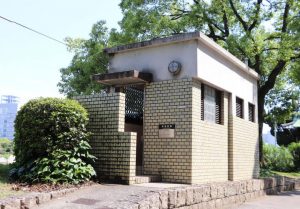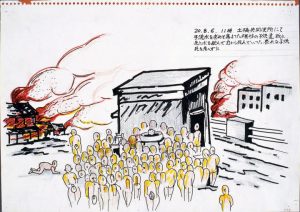Walking tour of A-bombed buildings—Honkawa public restroom, located in Hiroshima’s Naka Ward
Jun. 26, 2023
Restroom recently added to list of A-bombed buildings after verification in public survey
by Rina Yuasa, Staff Writer
A small public toilet in Dobashi-cho, an area located on the riverbank opposite Peace Memorial Park, in Hiroshima’s Naka Ward, is situated beside Honkawa River, seamlessly blending into the everyday surroundings. However, it happens to have been a “witness” to the violent blast and thermal rays from the atomic bombing at its location a mere 480 meters from the hypocenter.
The ferroconcrete structure measures about 12-square meters in area and is equipped inside with two Japanese-style toilets and two urinals. Owned by Hiroshima City, the restroom underwent renovations in 1989, including the replacement of tiles and the painting of exterior walls, among other renovation work.
In 2015, the unassuming public toilet was added to the list of A-bombed buildings by the city and designated the “Honkawa public restroom.” Tadashi Hino, 64, an illustrator living in Hiroshima’s Higashi Ward, first brought attention to the structure.
In 2014, Mr. Hino came across a structure that looked similar to the Honkawa public restroom in a video of the former Tsukamoto-cho area taken by the United States Strategic Bombing Survey team in March 1946. He and volunteers compared that image with the current restroom and identified the structure as being the same. Mr. Hino lobbied the city to register the restroom on the list. “No matter how small, such structures can provide a key to better understanding of the A-bombing tragedy.”
When the public restroom was built is unclear, although an existing photo taken around 1939 provides evidence of its existence at that time. Archived at the Hiroshima Peace Memorial Museum are materials indicating the situation of the restroom at the time of the atomic bombing. Among the “A-bomb drawings” illustrated by A-bomb survivors and submitted in response to a campaign conducted by the museum in the 1970s, one drawing is titled “At Dobashi public toilet, 11:00 a.m., August 6, 1945.” An additional description indicates that naked children looking for a washroom gathered at the toilet after the atomic bombing and died after drinking water there.
Hiroshima, where many river boats traveled up and down Honkawa River, has long been known as a city of water transportation. The stone stairs that remain on the river embankment near the restroom structure are a relic of that history. The area on the opposite side of the river, which was later developed into Peace Memorial Park, was also a bustling commercial area. The presence of the public restroom is proof of the area’s everyday circumstances, including a high volume of human traffic, prior to the atomic bombing.
(Originally published on June 26, 2023)









